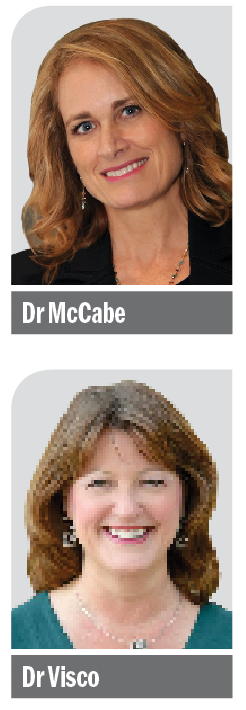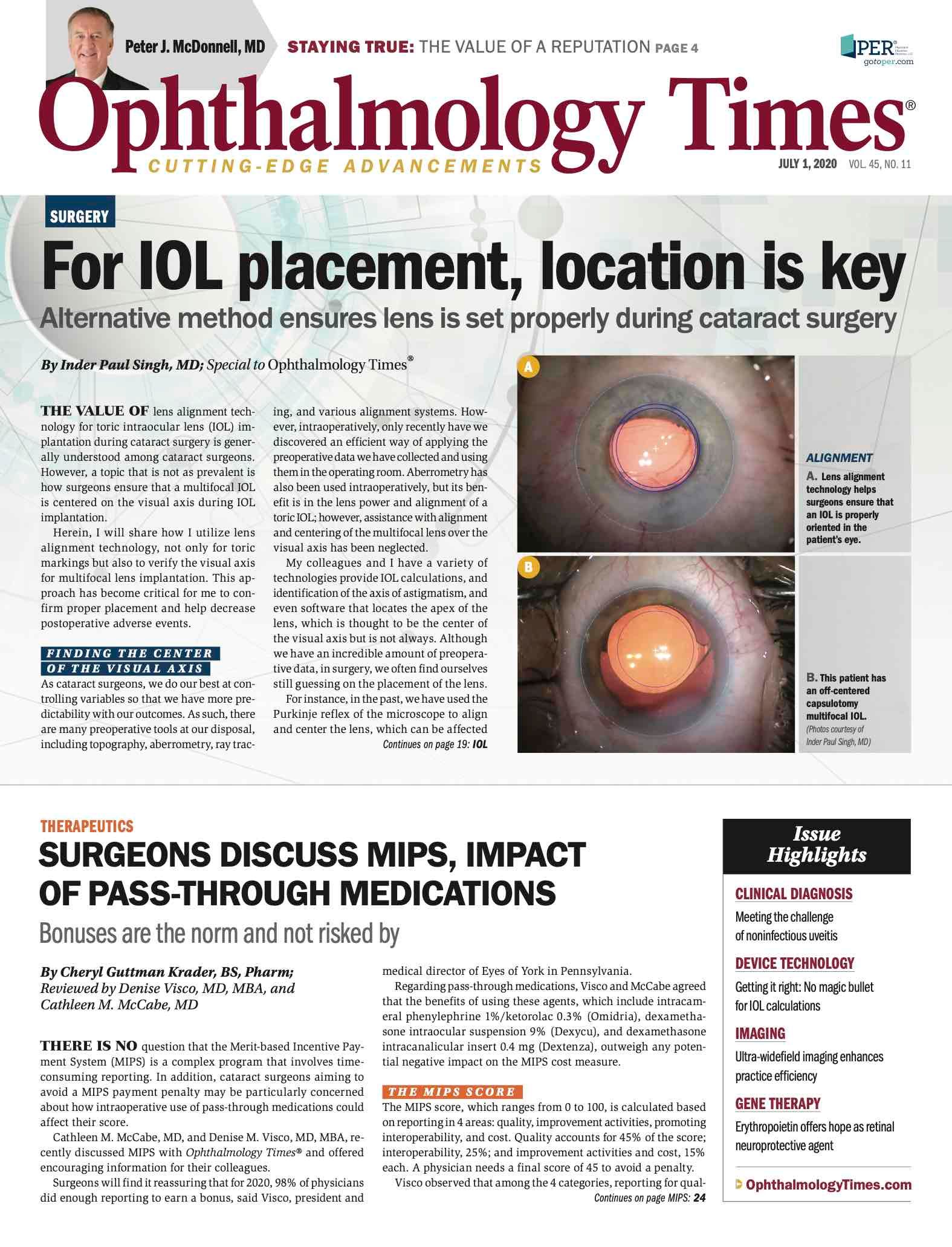Publication
Article
Digital Edition
Surgeons discuss MIPS, impact of pass-through medications
Author(s):
Bonuses are the norm and not risked by pass-through medication use


There is no question that the Merit-based Incentive Payment System (MIPS) is a complex program that involves time-consuming reporting.
In addition, cataract surgeons aiming to avoid a MIPS payment penalty may be particularly concerned about how intraoperative use of pass-through medications could affect their score.
Cathleen M. McCabe, MD, and Denise M. Visco, MD, MBA, recently discussed MIPS with Ophthalmology Times® and offered encouraging information for their colleagues.
Related: COVID-19: Keep calm and carry on emotionally and financially
Surgeons will find it reassuring that for 2020, 98% of physicians did enough reporting to earn a bonus, said Visco, president and medical director of Eyes of York in Pennsylvania.
Regarding pass-through medications, she and McCabe agreed that the benefits of using these agents, which include intracameral phenylephrine 1%/ketorolac 0.3% (Omidria), dexamethasone intraocular suspension 9% (Dexycu), and dexamethasone intracanalicular insert 0.4 mg (Dextenza), outweigh any potential negative impact on the MIPS cost measure.
The MIPS score
The MIPS score, which ranges from 0 to 100, is calculated based on reporting in 4 areas: quality, improvement activities, promoting interoperability, and cost.
Quality accounts for 45% of the score; interoperability, 25%; and improvement activities and cost, 15% each. A physician needs a final score of 45 to avoid a penalty.
Related: Glaucoma 360: Fostering innovation in the face of costs, policy issues
Visco observed that among the 4 categories, reporting for quality is the most burdensome. Because of its weight, this measure can’t be ignored in an attempt to stay above the threshold score for avoiding a penalty.
However, she described expending too much effort to achieve perfection as an exercise with diminishing returns.
“The negative adjustment and bonus programs are a budget-neutral process, and with nearly all physicians qualifying for a bonus, there is not much penalty money in the pool.
For example, based on 2018 reporting, the maximum bonus for 2020 will be just 1.68%,” explained Visco, who is also president of the American College of Eye Surgeons.
“The extra resources spent trying to increase one’s score cost more than you will receive in the way of a higher bonus. You are spending dollars to chase cents.”
Visco suggested that it might be most worthwhile to focus on improving the score for promoting interoperability, which can ultimately help streamline a practice’s overall functions, such as patient communications and services.
“The ability to upload information into the electronic health record and ensuring that your record is compatible with others and protects patient information are worth accomplishing,” she said.“
Related: New battles taking shape in fight to control drug costs
These functions may also decrease the amount of quality reporting necessary to keep your MIPS score above the penalty level.”
Concern about the effect of using pass-through medications on the cost measure is misplaced, according to Visco and McCabe. Looking at the impact from a broader perspective reveals why the thinking is flawed, they said.
The mission of all surgeons and practices is to provide high-quality care that will result in a high degree of patient satisfaction, said McCabe, who is chief medical officer at Eye Health America and medical director of The Eye Associates in Bradenton, Florida. The use of intracameral phenylephrine/ketorolac or intraocular dexamethasone suspension in cataract surgery can help surgeons achieve those goals.
“Using intracameral phenylephrine/ketorolac has benefits for increasing case efficiency, reducing the need for additional interventions, improving outcomes, and increasing patient satisfaction,” she said.
Visco cited research showing the agent’s benefits, including the results of a recently published study she conducted.
Related: How to approach the out-of-pocket pricing conversation with patients
The findings revealed that intracameral phenylephrine/ketorolac reduced rates of cystoid macular edema, breakthrough iritis, and postoperative pain.1 “All those issues bring patients back after surgery and therefore add to the cost of care,” she said.
Visco added that surgeons who question whether they might see the same benefits in their practices should consider findings from postmarket studies showing that intracameral phenylephrine/ketorolac decreases complications during cataract surgery and reduces the need for pupil expansion devices.
“If the added cost of using intracameral phenylephrine/ketorolac has any negative impact on the MIPS cost score, it is likely to be minimal, and its effect on the total score is likely just a drop in a larger bucket, having a minuscule impact on the amount of any bonus received,” Visco said.
Furthermore, a long list of comorbidities excludes difficult cases from the cost analysis, McCabe pointed out.
Related: Costs for glaucoma interventions
“The comorbidities include hypertension, diabetes, epiretinal membrane, history of intraocular inflammation, synechiae, and many others,” she said.
Outside of MIPS, surgeons should consider a generous manufacturer rebate program for intracameral phenylephrine/ketorolac. “This opportunity to improve the center’s financial status has taken on an even greater importance now that most surgery centers were closed for many weeks because of COVID-19 [coronavirus disease 2019],” she said.
ASC Quality Reporting
Briefly discussing the Ambulatory Surgical Center Quality Reporting (ASC) Program, Visco mentioned that owners of Medicare-certified ASCs filing at least 240 claims annually for 2020 must report on 4 of the 5 following quality reporting measures to avoid reduced payments in 2021: ASC-9 (Endoscopy/Polyp Surveillance: Appropriate Follow-Up Interval for Normal Colonoscopy in Average Risk Patients), ASC-11 (Cataracts: Improvement in Patient’s Visual Function within 90 Days Following Cataract Surgery), ASC-12 (Facility 7-Day Risk-Standardized Hospital Visit Rate After Outpatient Colonoscopy), ASC-13 (Normothermia), and ASC-14 (Unplanned Anterior Vitrectomy).
“Although only measures 11, 13, and 14 have relevance to cataract surgery, it is important to also pick either ASC-9 or ASC-12 and include it in the reporting, even if you are entering a 0 in the numerator and the denominator,” Visco concluded.
Read more by Cheryl Guttman Krader, BS, Pharm
---
Cathleen M. McCabe, MD
e:cmccabe13@hotmail.com
Dr McCabe is a speaker and consultant for Omeros, EyePoint Pharmaceuticals, and Ocular Therapeutix, and she receives research support from EyePoint Pharmaceuticals and Ocular Therapeutix.
Denise M. Visco, MD, MBA
e:dvisco@eyesofyork.com
Dr Visco is a speaker and consultant for and receives research support from Omeros, and she is a consultant for Ocular Therapeutix.
--
References
1. Visco DM, Bedi R. Effect of intracameral phenylephrine/ketorolac 1.0%/0.3% on postoperative cystoid macular edema, iritis, pain, and photophobia following cataract surgery. J Cataract Refract Surg. Published online Mar 26, 2020. doi:10.1097/j.jcrs.0000000000000193

Newsletter
Don’t miss out—get Ophthalmology Times updates on the latest clinical advancements and expert interviews, straight to your inbox.




